By Tom Travis
The newly elected Flint City Council held their first meeting Monday night since last week’s election. In line with the rules of the charter, the City Clerk, Inez Brown called the meeting to order and chaired the meeting until a president was chosen.
The longest serving council member, Eric Mays (Ward 1) was elected in a 5-4 vote in a single round of verbal nominations as president of the council. Councilpersons Judy Priestley (Ward 4), Jerri Winfrey-Carter (Ward 5), Tonya Burns (Ward 6) and Dennis Pfeiffer (Ward 8) along with himself nominated Mays for council president.
The remaining four councilpersons voted for Councilperson Ladel Lewis ( Ward 2).

City Clerk, Inez Brown shakes the hand of newly elected Council President, Eric Mays (Ward 1). (Photo by Tom Travis)
Mays moved to the president’s chair and took over the meeting. His first action was to call for council to nominate a council vice-president. Newly-elected Councilperson Allie Herkenroder (Ward 7) was elected as vice-president. Then, again following the charter, President Mays appointed council members as committee chairpersons and vice-chairpersons. The results are:
Finance Committee
Chair – Tonya Burns (Ward 5)
Vice-Chair – Judy Priestley (Ward 4)
Governmental Operations Committee
Chair – Jerri Winfrey-Carter (Ward 6)
Vice-Chair – Ladel Lewis (Ward 2)
Legislative Committee
Chair – Dennis Pfeiffer (Ward 8)
Vice-Chair – Allie Herkenroder (Ward 7), initially Mays offered this position to Councilperson Quincy Murphy (Ward 3) but he declined.
Grants Committee
Chair – Eva Worthing (Ward 9)
Vice-Chair – Judy Priestley (Ward 4)
Council President Mays told the council that he had “a vision of restructuring the city council.” He explained that, in the future, he would like to combine Grants and Finance committees and also combine Governmental Operations and Legislative committees. “We want to do some things to shorten our meetings,” he added.
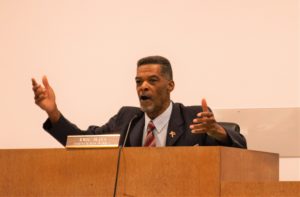
Council President Eric Mays chairs the first meeting of the newly elected council on Monday night. (Photo by Tom Travis)
The council meeting lasted five hours from 7:30 p.m. until after midnight. Future regularly scheduled council meetings will begin at 5:30 p.m. The charter stipulates that the first council meeting after the election begin at 7:30 p.m.
Civil and productive city council meeting
The city council’s behavior has roused the ire of many in the community over the past several years. Pleas from the community for the council to change their ways have]emerged through social media, Last night’s meeting ran smoothly without any yelling and without a single “point of order” or “point of information” — parliamentary maneuvers that have plagued meetings in the past. The new council worked through the entire agenda with all of the city’s business taken care of by the end of the evening.
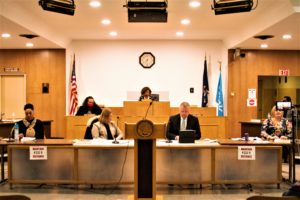
The newly elected council sat socially distanced and partially-masked in one of their first in-person meetings since City Hall reopened since the pandemic began. (Photo by Tom Travis)
In Monday’s meeting four councilpersons wore masks Lewis (Ward 2), Murphy (Ward 3), Winfrey-Carter (Ward 5), and Herkenroder (Ward 7). City administration officials present all wore masks throughout the meeting. They sat in the rear of council chambers sometimes going forward to the podium when asked to answer questions or offer comments.
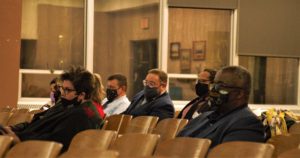
Some city administration officials sat near the back of council chambers during the meeting. (Photo by Tom Travis)
City officials present were Clyde Edwards, City Administrator; Robert Widigan, Chief Financial Officer (CFO); Amanda Trujillo, City Treasurer; Suzanne Wilcox, Director of Planning and Development; Raymond Barton, Fire Chief; Terence Green, Police Chief; Michael Brown, Director of Public Works; Angela Wheeler, City Attorney; Khalfani Stephens, Director of Economic Development.
Environmental Justice Advocate Mona Younis pleads with city council to take action
Mona Younis, Executive Director of Environmental Transformation Movement of Flint (www.etmflint.org) and an environmental justice advocate, addressed the council calling them to take action against a proposed asphalt plant to be built just outside of the northern border of the city in Genesee Township.
Calling attention to Monday’s action by the Michigan Department of Environment, Great Lakes and Energy (EGLE) of approving a permit for the asphalt plant to proceed with construction, Younis said, “This plant is going to hurt all of us.” EGLE has, “unfortunately, despite the out cry of thousands of Flint residents and Genesee Township residents, approved a permit to build the plant.”
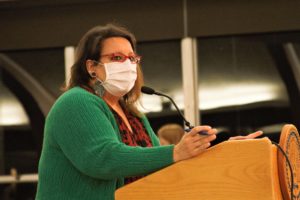
Environmental justice advocate, Mona Younis, speaks to the council suggesting actions they can take against a proposed asphalt company just north of the Flint border. (Photo by Tom Travis)
Younis noted concerns about the plant have been raised at the federal level, specifically mentioning H.U.D. (U.S. Department of Housing and Urban Development) and EPA (U.S. Environmental Protection Agency).
“Still EGLE did what it does, which is to prioritize money and prioritize business over people of color in our community. This is, unfortunately, an issue that permeates statewide but we are feeling it here at home.”
Younis called specific elements of the situation to the council that she said were “relevant” to them and asked them to take action. She asked them to write a letter of reaffirmation to EGLE explaining that, “they [EGLE] have the power to delay this permit further, and require them to conduct a cumulative impact analysis.”
A cumulative impact analysis would look at all the pollution that is in the area of the proposed asphalt plant including other polluting industries in the Genesee Township area and further south along industrial areas on Dort Hwy into the Flint area, Younis explained. “All those industries together create what is called a “cumulative burden,” she said.
“Part of the reason why this is so problematic for our community is that right across the street from the proposed Ajax plant is River Park and Ridgecrest. These are two of Flint’s largest low-income housing complexes, including the largest public housing complex in the city. There is all this industry right around all of these people who really can’t escape it.”
In the 1990s as other polluting industries moved into the area, there was “very strong opposition” and environmental protests, Younis recalled. “The plant [that was allowed to be built in the 90s] was allowed to pollute even more than what was in the original permit.
“That is part of the fear — that once a plant is built they can expand the amount of pollution they are allowed to permit.” Younis pleaded. “So we need to continue to stand strong and oppose this permit.”
Younis challenged the council by saying, “We want you to consider sending a reaffirmation to the EPA standing against the permit.” She said the council has already done that for EGLE and now is asking them to do the same sending the reaffirmation to the EPA, Gov. Whitmer and the media. She asserted, in an “unusual action,” the EPA “weighed in on a local permit issue,” saying EGLE needs to require a cumulative impact analysis to pause the process.

One of many signs protesting the Ajax asphalt plant along Flint’s northern border by Genesee Township. (Photo by Tom Travis)
Younis pointed out that when EGLE approved the permit for Ajax to build, they told the EPA “We need help in figuring out the cumulative impact.” Younis asserted that EGLE already had the help they needed but refused to act on it. She pleaded for “a continued strong push” from the community
“They need to act and follow through with the cumulative impact analysis,” she asserted.
In addition, Younis explained the EPA has told Ajax and Genesee Township leadership that they need to look at an alternative site. Younis challenged the council to ask EGLE to work with county officials to discover an alternative site and to conduct a cumulative impact analysis.
“Ward 3, the area of Flint immediately surrounding the proposed Ajax plant site, has the highest asthma hospitalization rates in the state according to state health data,” Younis stated.
Council President Mays (Ward 1) asked Younis what is the time frame for council to do what she requested. Younis explained that there is a 90-day window to get an injunction through the courts. Younis said this “is a legal window” but Ajax can begin building tomorrow. “Let’s be very clear,” she warned. “They have cleared that land and are ready to build.”
Council President Mays named Councilpersons Quincy Murphy (Ward 3) and Allie Herkenroder (Ward 7) as an ad hoc committee to work with Younis and environmental justice advocacy groups in the future.
Younis further challenged the council to adopt a “Community Benefits Ordinance [CBO].” A CBO is a law that requires developers to proactively engage the community to identify community benefits and address potential potential negative impacts of certain development projects, according the City of Detroit website which has adopted a CBO in 2021. Younis explained that what this would do is to insure Flint would have community benefits from any industry moving into Flint.
Local nurse asks council to consider using American Rescue Plan funds toward “premium pay” for healthcare workers
During public speaking, Janey Robertson, 40, a CNA (Certified Nurses Assistant) asked the council to consider using some of the American Rescue Plan (ARP) funds to provide premium pay for healthcare workers for the added work load they are experiencing during the COVID pandemic.
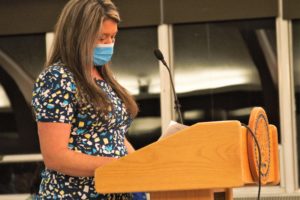
Local nurse Janey Robertson, asks the council to consider using some of the American Rescue Plan stimulus money towards salaries for healthcare workers. (Photo by Tom Travis)
After the meeting, Robertson told EVM she has not been vaccinated and has not had COVID. “I feel that my natural immunities are enough,” she said. “I haven’t had it [COVID] the whole time.” Robertson said she has seen people die from COVID and said that some of those who died were vaccinated while others were not.
“I love doing my job because I can help people through their daily struggles so that they can feel better and go home to their families,” she told the council. “I always strive to give my patients the best care.” Robertson, in her comments, recalled the fulfilling feeling she had walking patients out to their cars to go home. “I’m proud to say that I was part of their journey.” She explained that some of the patients came to her rehab facility on “vents” and “very sick” and often unable to even get out of bed.
A group of fellow nurses came to support Robertson as she addressed council. (Photo by Tom Travis)
“This pandemic has been very tough on me and my co-workers. I patiently urge you guys to use ARP (American Rescue Plan) funds to recognize our work with premium pay. This will not only help us but help to maintain the work force because we are so short staffed, to care for the aging population. Just please, if you guys could remember us.”
EVM Managing Editor Tom Travis can be reached at tomntravis@gmail.com.

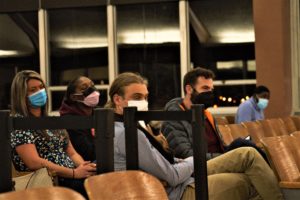

You must be logged in to post a comment.